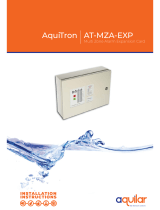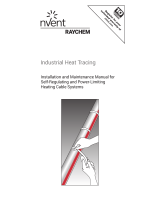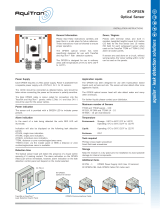Page is loading ...

Checklist of Installation Steps
Leak Detection Systems
Commercial Buildings Installation Instructions
Store sensing cables properly
Prepare for the installation and
schedule it at the proper time
Prepare the area where the
sensing cable will be located
Observe proper precautions
when handling sensing cables
Install and test the
TraceTek alarm module
Install sensing cable in accordance
with instructions
Test sensing cable after installation
Complete the leak detection system
and activate it as soon as possible
Verify that the system is operational
Prepare as-builts, and have TraceTek
system tested, mapped, and commissioned
Verify that major
construction is complete
4
1
3
4
2
5
6
7
8
9
10
11
1
2
5
3
6
7
8
9
10
11
Train owner/operator
12
12
Check ListSteps

2 | nVent.com
For details, these general instructions refer to other nVent literature which is identied by an H-number. Consult nVent at (650) 216-1526.
STEP: FOR DETAILS REFER TO:
1. Store sensing cables properly.
Store the sensing cable in the original container in a clean, dry
area prior to installation.
• nVent RAYCHEM TraceTek TT1000 Modular Sensing Cable
Installation Instructions (H55555)
2. Prepare for the installation and schedule it at the proper time.
• Conrm there is a plan for the leak detection system layout,
and a complete bill of materials.
• Ensure that all materials are available (including sensing
cable lengths, end terminations, branching connectors,
jumper cables, hold-down clips, and other accessories).
• Plan installation of the sensing cable only after major
construction (which could damage or contaminate the
cable) is complete.
• If possible, plan to install the alarm module rst so it can
be used to monitor sensing cable immediately after cable
installatio
n.
• Schedule training (by a qualied organization) for those who
will install the TraceTek system.
• Water Sensing Systems Selection Guide (H53874)
• nVent RAYCHEM TraceTek Installation Training Record (H55554)
3. Install and test the TraceTek alarm module.
Install and test alarm module in accordance with installation
instructions shipped with the unit.
• Alarm Module Installation Instructions (instructions are specic to
the module; follow the instructions that come with it)
4. Verify that major construction is complete.
• Check that construction that could damage or contaminate the
sensing cable has been completed.
5. Prepare the area where the sensing cable will be located.
• Clean the area where the cable will be installed, to remove
debris and sources of contamination.
• For suboor, sumps, and similar applications, install TraceTek
hold-down clips, positioning them so sensing cable will provide
desired leak detection coverage.
• TT1000 Modular Sensing Cable Installation Instructions (H55555)
6. Observe proper precautions when handling sensing cables.
Do
• Store the sensing cable in a clean, dry area prior to installation.
• Install sensing cable after major construction is complete.
• Clean the area where the cable will be installed.
Don’t
• Drag the sensing cable through contaminants (such as pipe
dope, PVC cement, acetone or other solvents, oil, or dirt).
• Use damaged or contaminated sensing cable.
• Solder or weld near the cable without protecting it from heat,
ux, and splatter.
• Drop tools or sharp or heavy objects onto the cable.
• Pull the sensing cable with excessive force (more than
50pounds/20 kg).
• Use adhesive tapes or unapproved clamping devices to
permanently secure the sensing cable.
• Allow cable connectors to become wet, dirty, or contaminated.
Installation Steps

nVent.com | 3
STEP: FOR DETAILS REFER TO:
7.Install sensing cable in accordance with instructions for your application.
The proper installation procedure depends on the application.
Installation instructions for TraceTek TT1000 modular sensing
cable cover common applications in commercial buildings
(such as computer room subfloors and sumps). For different
types of applications (such as double-contained piping),
different procedures and/or TraceTek products are required.
If there is any doubt, consult your TraceTek representative.
• TT1000 Modular Sensing Cable Installation Instructions (H55555)
8.Test the sensing cable before and after installation.
To ensure that each length of sensing cable is intact and
free of contamination, follow test procedures detailed in the
installation instructions included with your sensing cable.
• TT1000 Modular Sensing Cable Installation Instructions
(H55555)
• Operating Instructions for Portable Test Box (H55524)
9.Complete the leak detection system and activate it as soon as possible.
• Install other TraceTek circuit components, such as
TraceTek modular branching connectors
(nVent RAYCHEM TraceTek TT-MBC-PC), as called for in
the system layout; complete the sensingcircuit.
• Connect the sensing circuit to the alarm module and
activate the system as soon as is practical. Use the
module to monitor the cable for events during the nal
stages of construction. Identify and correct problems as
they are detected.
• Component Installation Instructions (instructions are specic
to the component; follow the instructions that come with it)
10.Verify the system is operational.
• Verify that the system is fully operational and ready for
use; the TraceTek Precommissioning Record provides a
useful checklist.
• Precommissioning Record (H55550)
11.Prepare as-builts and have the TraceTek system tested, mapped, and commissioned.
• Gather and record as-built information while the system is
still accessible.
• Have a qualied organization test, commission,
and (for locating systems) map the TraceTek leak
detectionsystem.
• Commissioning Record for the TraceTek alarm module
(specic to the type of alarm module)
12.Train the owner/operator
• Identify the persons or groups in the owner/operator
organization who will be responsible for the leak
detection system. Have them trained in the operation and
maintenance of the system.
• Operating Manuals (specic to the type of alarm module)

©2018 nVent. All nVent marks and logos are owned or licensed by nVent Services GmbH or its aliates. All other trademarks are the property of their respective owners.
nVent reserves the right to change specications without notice.
RaychemTraceTek-IM-H55522-CommercialLeakDetection-EN-1805
nVent.com
North America
Tel +1.800.545.6258
Fax +1.800.527.5703
Europe, Middle East, Africa
Tel +32.16.213.511
Fax +32.16.213.604
Asia Pacific
Tel +86.21.2412.1688
Fax +86.21.5426.3167
Latin America
Tel +1.713.868.4800
Fax +1.713.868.2333
/




